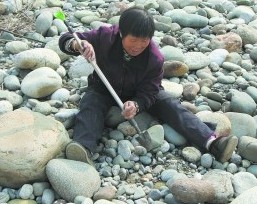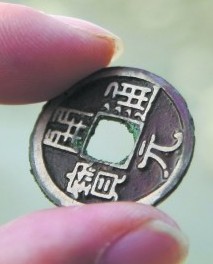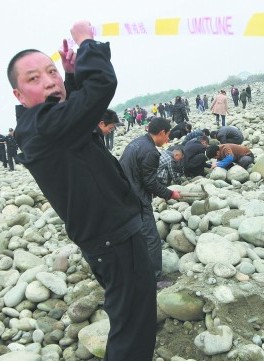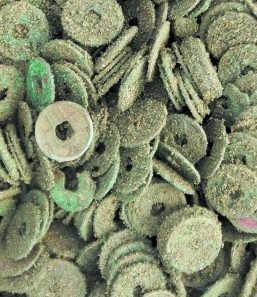More than 100 local villagers were seen busily overturning rocks in a small flood plain area of Sichuan Province’s “Golden Horse River” (金马河) once word spread that a large number of ancient Chinese coins had been discovered, according to a report by the Sichuan News Network (四川新闻网).

Villager digging for coins
Villagers of the Wenjiang District (温江区) of Chengdu City (成都市) arrived with shovels, hoes, sickles and any other digging implement they could find to turn over the cobblestones.
Casual observers first thought the villagers were digging up edible “whip worms” (皮鞭虫) before they realized that there was real “treasure” buried there.
Some of the treasure hunters came away with several kilograms of coins while others were only able to find 10 or 20 coins.
The discovery is considered particularly unusual because, unlike most hoards, these bronze cash coins come from many different dynasties.

The oldest coins are wu zhu (五铢) coins from the Han Dynasty (206 BC-220 AD) and huo quan (货泉) coins dating from Wang Mang’s Xin Dynasty (7-23 AD).
The most recent coins were cast during the reign of the Qianlong Emperor (乾隆 1736-1795) and the Guangxu Emperor (光绪 1875-1908) of the Qing Dynasty.
The coins thus span almost 2,000 years of Chinese history.
The vast majority of coins, however, are from the Tang Dynasty (618-907). Most have the inscription kai yuan tong bao (开元通宝) but some have the inscription qian yuan zhong bao (乾元重宝).

Local police try to cordon off the area
The frantic activity attracted the notice of the authorities who immediately called in the police to prevent further “looting” and to protect the site.
Experts from the local Bureau of Cultural Relics were also dispatched to carry out research.
The Chengdu archaeologists determined that the coins were strewn over an area approximately 200 meters long and 100 meters wide. The archaeologists themselves were able to dig up more than 5 kilograms of coins in a short period of time.
While it still has not been determined how the ancient coins came to be scattered along the rocky bottom of the Golden Horse River, two of the archaeologists were willing to speculate.

Coins from the Han to the Qing Dynasties spanning 2,000 years
Mr. Liu Yumao (刘雨茂) said that throughout history, it has been the custom to place old coins into structures built for irrigation and water conservancy as a means to promote good fortune and to avoid disaster. He said the coins may have been buried in such a structure that eroded and washed away over time. The coins could then have been carried by the river current and deposited in this area.
As to why the majority of coins are from the Tang Dynasty, Mr. Wang Zongxiong (王仲雄) said that in olden times heavy cargoes were transported by rivers and canals. It is possible that during the Tang Dynasty a boat carrying coins may have sunk and the coins were hidden underwater until now.
According to the cultural relics experts, it is not practical to try to excavate or even preserve the site because of the possibility of flood waters suddenly appearing.
The authorities are encouraging the villagers not to continue to dig for coins or worms because of the danger.
Although the coins are very old, they are still considered to be very common.
Nevertheless, the villagers are asked to return all the coins to the authorities because, according to law, all cultural relics buried on land or found in the waters or seas within the territorial boundaries of China are considered to be the property of the state.